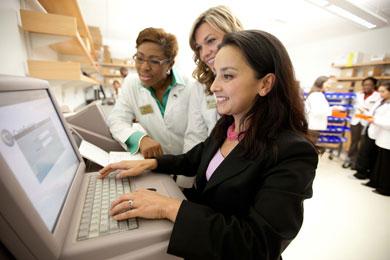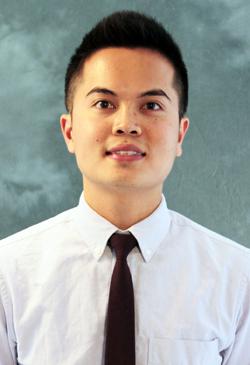New Practice Sites Reinforce SOP as a Leader in Maryland Pharmacy Practice
University of Maryland Baltimore Washington Medical Center announced as latest practice site for PPS faculty, joining sites previously established at Giant, Johns Hopkins Hospital, and Georgetown University Hospital.

By Malissa Carroll
October 18, 2013
To help expand cutting-edge pharmacy services to people across the state of Maryland, as well as offer more innovative educational experiences for student pharmacists and residents, the University of Maryland School of Pharmacy recently established a practice site for faculty in the Department of Pharmacy Practice and Science (PPS) at the University of Maryland Baltimore Washington Medical Center. The opening of this practice site follows the creation of three new practice sites at Giant Pharmacy; the Johns Hopkins Home Care Group (JHHCG), a full-service home care provider owned and operated by Johns Hopkins Health System; and Georgetown University Hospital.
“With the formation of these new practice sites, our faculty will have many exciting opportunities to shape new, innovative clinical services to benefit individuals living in the state of Maryland and beyond,” says Magaly Rodriguez de Bittner, PharmD, BCPS, CDE, FAPhA, professor and chair of PPS. “The University of Maryland Baltimore Washington Medical Center has served as a training site for our students for many years, and as our partnership continues to mature, we look forward to increasing the breadth and depth of the clinical pharmacy services available to patients, as well as establishing the hospital as a key partner for exemplary advanced practice experiences for our students.”
Located in Glen Burnie, the University of Maryland Baltimore Washington Medical Center became a member of the University of Maryland Medical System in 2000. The new practice site, led by James Trovato, PharmD, MBA, BCOP, FASHP, associate professor in PPS, and Leah Sera, PharmD, assistant professor in PPS, will specialize in the areas of oncology and pain management.
“The University of Maryland Baltimore Washington Medical Center provides exposure for our students and residents to the unique environment of a community hospital, while also offering faculty the opportunity to work with other health care professionals at the hospital to expand existing clinical and education programs,” says Trovato. “This is a win-win situation, and by working together in this partnership, both the School of Pharmacy and the University of Maryland Baltimore Washington Medical Center can benefit from these opportunities.”
Faculty at the Giant Pharmacy, JHHCG, and Georgetown University Hospital practice sites also provide a wide range of specialized pharmacy services that complement existing programs available at each site.
Deanna Tran, PharmD, assistant professor in PPS, manages the Giant Pharmacy practice site, where she hopes to incorporate wellness programs focused on immunizations, blood pressure, and point-of-care testing into the current pharmacy setting.
“I am honored by the opportunity to work with staff at Giant Pharmacy,” says Tran. “It is the only grocery store-based chain pharmacy to partner with a school of pharmacy in the state. I am confident that the programs and services that we implement will directly influence a large group of pharmacists and, ultimately, more patients.”
The practice site with JHHCG, which is located at John Hopkins Hospital and led by Tim Rocafort, PharmD, assistant professor in PPS, hopes to expand outpatient services to transplant patients, while Amy Ives, PharmD, and Connie Yoon, PharmD, assistant professors in PPS, will work with patients at Georgetown University Hospital to provide medication reconciliation, discharge counseling, and transition of care services.
“Normally, transplant patients remain in the hospital, with pharmacists only working to dispense medications in the outpatient setting,” says Rocafort. “With this new practice site, however, we are aiming to increase collaboration with nurse practitioners, case managers, physicians, and inpatient pharmacists to provide more coordinated care in the outpatient setting. We have access to great resources and great people to help us accomplish our goal.”
In addition to providing invaluable services to patients, these practice sites also enrich practice experiences for student pharmacists, who are mentored by faculty preceptors at each site, and residents.
While Tran and Rocafort are excited to expand existing opportunities available to student pharmacists and residents at their respective practice sites, Ives looks forward to providing students and residents with a new location at which they can gain first-hand pharmacy experience.
“Establishing a practice site at Georgetown University Hospital allows the School of Pharmacy to expand the number of experiential opportunities available to students within close proximity to the Shady Grove campus,” says Ives. “The hospital has an exceptionally progressive pharmacy department, and students will have the opportunity to participate on interdisciplinary rounds with medical residents and other health care professionals. Likewise, because Georgetown University Hospital is a large teaching hospital, students have the potential to be exposed to a wide range of disease states that they might not see elsewhere.”
The University of Maryland Baltimore Washington Medical Center is also currently available as a rotation site for students completing their introductory pharmacy practice experiences, but Trovato hopes to expand these offerings in the future. “I believe that opportunities exist to encourage more clinical pharmacists at the hospital to serve as preceptors and help broaden and develop more student and resident rotations,” he says.



